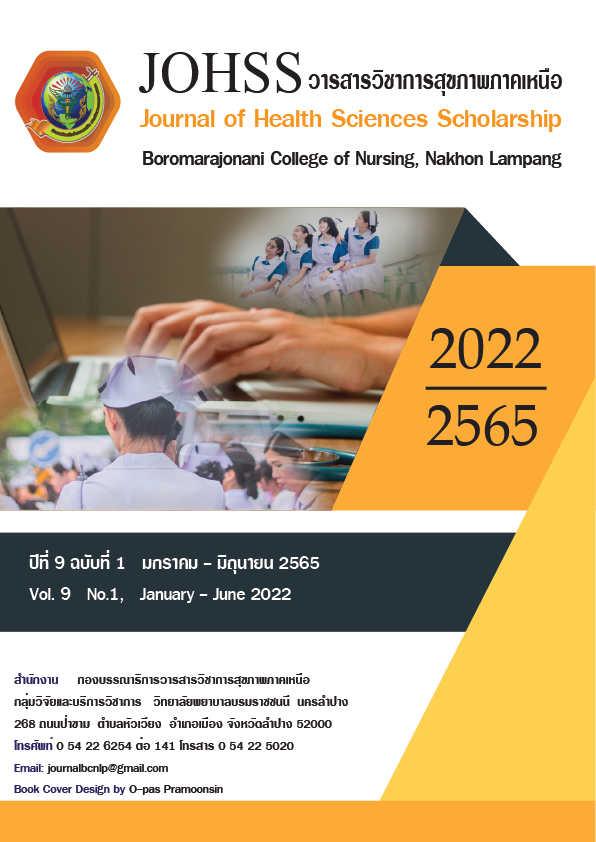ปัจจัยทำนายการควบคุมความดันโลหิตของผู้เป็นโรคความดันโลหิตสูงในเขตอำเภอเมือง จังหวัดลำปาง
คำสำคัญ:
ความรอบรู้ด้านสุขภาพ, พฤติกรรมสุขภาพ, ความดันโลหิตสูงบทคัดย่อ
การวิจัยเชิงทำนายครั้งนี้มีวัตถุประสงค์เพื่อศึกษาปัจจัยทำนายการควบคุมความดันโลหิตของผู้เป็นโรคความดันโลหิตสูงในเขตอำเภอเมือง จังหวัดลำปาง จำนวน 385 คน โดยเป็นผู้ป่วยโรคความดันโลหิตสูงอายุตั้งแต่ 35 ปี ขึ้นไปที่ขึ้นทะเบียนรับการรักษาในเขตอำเภอเมืองจังหวัดลำปางกลุ่มตัวอย่างได้มาโดยวิธีการสุ่มหลายขั้นตอน (Multi-stage random sampling) เก็บรวมรวมข้อมูลโดยใช้แบบสอบถามประกอบด้วย แบบสอบถามข้อมูลส่วนบุคคลและข้อมูลเกี่ยวกับการรักษา แบบสอบถามความรอบรู้ด้านสุขภาพ และแบบสอบถามพฤติกรรมการดูแลตนเอง เครื่องมือผ่านการตรวจสอบความเชื่อมั่นของเครื่องมือโดยนำไปทดลองใช้กับกลุ่มผู้ป่วยโรคความดันโลหิตสูงที่มีคุณลักษณะเหมือนกับกลุ่มตัวอย่างจำนวน 30 ราย โดยวิธีหาสัมประสิทธิ์แอลฟาของครอนบาคมีค่าความเชื่อมั่น 0.70 และ 0.88 ตามลำดับ วิเคราะห์ข้อมูลโดยใช้สถิติพรรณนาและ Binary logistic regression
ผลการวิจัย พบว่า กลุ่มตัวอย่างสามารถควบคุมความดันโลหิตได้ตามเกณฑ์ ร้อยละ 59 จำนวนกลุ่มยาที่ใช้ในการรักษาโรคความดันโลหิตสูง (OR = 2.91, CI= 1.20-7.03, p = .018) การมีโรคร่วม (OR = 1.53, CI= 1.01-2.33, p = .044) และความรอบรู้ด้านสุขภาพ (OR = 1.02, CI= 1.0-1.05, p = .044) เป็นปัจจัยที่สามารถทำนายการควบคุมความดันโลหิตของกลุ่มตัวอย่าง โดยปัจจัยทั้ง 3 ร่วมกันทำนายได้ร้อยละ 3.8 (Cox and Snell R2 = .038) ความรอบรู้ขั้นการมีวิจารณญาณ เพียงด้านเดียวที่เป็นปัจจัยทำนายการควบคุมโลหิต (OR = 1.120, CI= 1.021-1.229, p = .017) ผลการศึกษานี้ใช้เป็นแนวทางในการเสริมสร้างความรอบรู้ด้านสุขภาพแก่ผู้ป่วยโรคความดันโลหิตสูงเพื่อให้สามารถควบคุมความดันโลหิตได้ตามเกณฑ์การรักษา
เอกสารอ้างอิง
Aekplakorn, W. (2021). The sixth national health examination survey of Thailand population
(2019-2020). Bangkok: Faculty of medicine Ramathibodi hospital Mahidol University. (in Thai)
Chontichachalalauk, J. (2015). Transalation and evaluation of version of the Diabetics Numeracy
test for olders adults with type 2 diabetes. the United States: The University of Texas at Austin.
Division of Non-Communicable disease. (2021). Indicators to monitor service quality non-
communicable disease operations (diabetes and high blood pressure) Fiscal Year 2022. Retrieved. (2022, February 12) from. http://www.thaincd.com/2016/media- detail.php?id=14109&tid=&gid=1-015-005. (in Thai)
Dumrongwuttichot N..(2021).The relationship between health literacy and health care behaviors of hypertensive patients in Muang Lampang, Lampang.Independent study,Boromarajonani College of Nursing, Nakhon Lampang.
Don Nutbeam. (2008). The evolving concept of health literacy . Social science and Medicine 57(12), 2072-2078.
GBD 2019 Risk Factors Coolaborators. (2020). Global burden of 87 risk factors in 204 countries and territories, 1990-2019: systematic analysis for the global burden of disease study 2019 369(10258). The Lancet , 1223-1249.
Katainoi. H., Danyuththasilpe, C., Noosorn, N. & Sririphonphaibun, T. (2015). Factor predicting blood pressure level among risk persons with hypertension. Journal of nursing and health sciences 9(3), 122-132. (in Thai)
Kareesun, K., Malathum, P. & Sutti, N. (2019). Relationship among health literacy knowledge about hypertension control and health behavior in older persons with hypertension. Ramathibodi Nursing Journal, 25 (3), 280-295. (in Thai)
Lampang Provincial Public Health. (2021). HDC Lampang. Retrieved. (2022, February 12). from.
https://lpg.hdc.moph.go.th/hdc/main/index.php.
Mills, T.K, Stefanescu, A. & He. J. (2020). The global epidermiology of hypertension. Nat Rev Nephrol 16(4), 223-237.
NCD Risk Factor Collaboration. (2021). Worldwide trends in hypertension prevalence and progress in treatment and control from 1990 to 2019: a pooled analysis of 1201 population-representative studies with 104 million participants. 398. Lancet , 957-980.
Pakdevong, N. and Binhosen, V. (2014). Factor predicted blood pressure control in persons with
hypertension in one community hospital. Journal of Nursing and health care, 32(1)23-30. (in Thai)
Pinprapapan, E., Junlapeeya, P., Saovapha, B., Ongkan, T., Sudjainark, S. (2556).
Predicting Factors of Controlling Blood Pressure Among Persons with hypertension in Lampang Province. Interdisciplinary Life-Course Human Potentials Development: Socio-Economic, Educational, Health and Nursing Perspectives, 763-774.
Promsena, Y. (2007). Self-behavior among hypertensive patients at hypertension clinic, Nakornping Hospital. Chiang Mai : Chiang Mai University .
Roma, W. and Kloyiam, S. (2019). Thai Health Literacy Survey (THL-S) of Thais aged 15 years
and above, 2019. Nonthaburi: Health System Research Institute.
Thai Hypertension Society. (2019). Thai Hypertension Society: Guidelines in the Treatment of
Hypertension 2019. Retrieved. (2022, February 12) from. http://www.thaihypertension.org/files/HT%20guideline%202019.with%20watermark.pdf.
Thongma, P. (2020). Health literacy and health outcomes in hypertensive patients . Thai Read Cross Nursing Journal 13(1), 50-62. (in Thai)
Wannasirikul, P., Termsirikulchai, L., Sujirarat, D., Benjakul, S. & Tanasugarn, C. (2016). Health literacy, medication adherence, and blood pressure level among hypertensive older adults treated at primary health care centers. Southeast asian journal of tropical medicine and public health 47(1), 109-120.
Woradaphakhna, L. (2020). An analytical study of health literacy and monks health care behaviors according to Dhamma-Vinaya to compliance with the health recommendations. Journal of graduate studies review 16(2), 129-138.
ดาวน์โหลด
เผยแพร่แล้ว
ฉบับ
ประเภทบทความ
สัญญาอนุญาต
ลิขสิทธิ์ (c) 2022 วารสารวิชาการสุขภาพภาคเหนือ

อนุญาตภายใต้เงื่อนไข Creative Commons Attribution-NonCommercial-NoDerivatives 4.0 International License.
บทความ ข้อมูล เนื้อหา รูปภาพ ฯลฯ ที่ได้รับการตีพิมพ์ในวารสารวารสารวิชาการสุขภาพภาคเหนือ ถือเป็นลิขสิทธิ์ของวารสารวารสารวิชาการสุขภาพภาคเหนือ หากบุคคลหรือหน่วยงานใดต้องการนำทั้งหมดหรือส่วนหนึ่งส่วนใดไปเผยแพร่ต่อหรือเพื่อกระทำการใดๆ จะต้องได้รับอนุญาตเป็นลายลักอักษรจากวารสารวารสารวิชาการสุขภาพภาคเหนือก่อนเท่านั้น
เนื้อหาและข้อมูลในบทความที่ลงตีพิมพ์ในวารสารวิชาการสุขภาพภาคเหนือถือเป็นข้อคิดเห็นและความรับผิดชอบของผู้เขียนบทความโดยตรงซึ่งกองบรรณาธิการวารสาร ไม่จำเป็นต้องเห็นด้วย หรือร่วมรับผิดชอบใดๆ
อนึ่ง ข้อความและข้อคิดเห็นต่างๆ เป็นของผู้เขียนบทความนั้นๆ ไม่ถือเป็นความเห็นของวารสารฯ และวารสารฯ ไม่จำเป็นต้องเห็นด้วยกับข้อความและข้อคิดเห็นใดๆ ของผู้เขียน วารสารฯ ขอสงวนสิทธิ์ในการพิจารณาตีพิมพ์ตามความเหมาะสม รวมทั้งการตรวจทานแก้ไขหรือขัดเกลาภาษาให้ถูกต้องตามเกณฑ์ที่กำหนด



